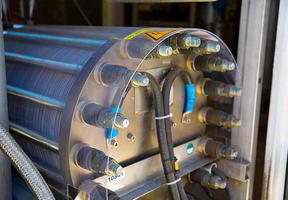Electric Powertrains
10 min read
The idea of powering a car with is far from new. In fact, the first electric vehicles came into existence back in the 19th century. Overshadowed for many years by the dominance of the internal combustion engine (ICE), electric vehicles are now making a comeback, spurred by widespread recognition of the need for an .

© AFP PHOTO / FRED TANNEAU
Hybrid Vehicles
The electric hybrid vehicle was first launched as a series-production model by Toyota in 1997, with Honda quickly following suit. The idea is to use a gasoline or -fueled internal combustion engine when it is most efficient — during cruising — and to add an electric motor for starting up and changing gears. This is because the thermal efficiency of an internal combustion engine, which is around 35% when cruising, can drop to as low as 15% when the vehicle stops and starts regularly, such as during city driving.
Based on these factors, a hybrid vehicle runs as follows:
- When starting up, only the electric motor is used.
- In normal driving conditions and when accelerating sharply, both the electric motor and the internal combustion engine are used and a sophisticated electronic system balances their respective contributions to achieve greater fuel economy.
- When slowing down and braking, the is converted into electricity to recharge the battery.
Hybrid vehicles can have very different degrees of electrification:
- In micro-hybrids, the electric motor provides only minimal backup to the internal combustion engine. This is the case, for example, with the basic stop-and-start system, which automatically shuts off and restarts the engine when the vehicle stops at a traffic light. The reduction in fuel consumption is very low, at around 5%.
- Mild hybrids go one step further by providing an electric motor that assists during acceleration. This type of hybrid emits 20 grams less CO2 per kilometer.
- Full hybrids can actually run on electricity alone, but generally use both the ICE and the electric motor. This type of vehicle emits 30 grams less CO2 per kilometer.
Full hybrids have an electric-only range of just a few kilometers, and are not intended solely for such use. Carmakers have designed a model, known as a plug-in hybrid, which can be recharged via an ordinary electrical outlet. After being plugged into a household socket for around three hours, the vehicle has an electric range of approximately 40 kilometers, consumes 50% to 90% less gasoline and emits only minimal amounts of CO2. However, these models are significantly more expensive than conventional hybrids.
All-Electric Vehicles
All-electric vehicles, which do not use internal combustion engines, have the advantage of generating zero carbon emissions during use. However, carbon emissions may well have been generated during the production of the electricity used to power the vehicle. In a country like France, which has significant nuclear power generation capacity, these emissions are relatively low. But in a country that uses natural gas or to produce electricity, they can far exceed the carbon emissions generated by an internal combustion engine vehicle. For example, an all-electric vehicle that runs on electricity produced “in Europe” (based on the average across all countries) would generate the same amount of carbon emissions as an internal combustion engine vehicle that uses two liters of fuel per 100 kilometers.
Of course, the main technological challenge with all-electric vehicles is battery range, which varies greatly depending on how the vehicle is used. With moderate use of electrical accessories, such as windscreen wipers, lights and heating, the five-door Renault Zoe city sedan, for example, offers a range of 210 kilometers in urban areas, but only 100 to 150 kilometers for suburban driving.
Research into lithium-ion and lithium-polymer batteries aims to increase vehicle range by 50% to 100%. Such an improvement would make a big difference, but it would not change the fact that electric vehicles require the creation of a dense – and therefore costly – network of fast charging stations, where vehicles can be charged in around 30 minutes rather than the eight hours necessary with conventional electric charging systems. Another obstacle is that, despite strong government incentives in many countries, electric vehicles have a much higher price tag than conventional ones.
Another option for all-electric vehicles is to use a -powered . In this case, the vehicle runs exclusively on pressurized hydrogen gas. But many challenges still need to be overcome.
Excellent Development Prospects
While the number of electric vehicles worldwide remains low, development prospects are excellent. According to a report from the , there were around two million all-electric and plug-in hybrid vehicles in 2016, accounting for 0.2% of automobiles worldwide1. Carmakers estimate that the number of electric vehicles could reach 10 million to 20 million by 2020, and 70 million by 2025. China has taken the lead in this area, with a 40% share of the global market – more than double that of the United States. In addition, there is an even greater number of nonplug-in hybrids on the road. Toyota, the largest and oldest carmaker in this segment, announced in February 2017 that it had sold more than 10 million such vehicles in the past 20 years.






















